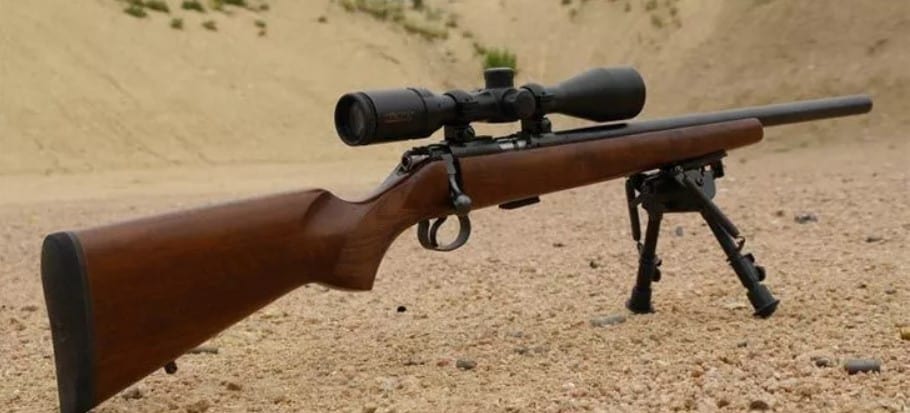Most shooters are scoping their .17 HMR completely wrong. They’re either slapping on whatever 3-9x scope they had lying around, or they’re going full tactical with high-magnification optics designed for centerfire precision work. Both approaches miss what this cartridge actually needs.
The .17 HMR occupies strange territory. With a 2,550 fps muzzle velocity and essentially zero drop to 100 yards, it shoots flat enough to tempt you into treating it like a long-range rig. But that 17-grain bullet gets pushed around by wind starting around 175 yards, and energy drops off a cliff past 200. You’re not building a precision rifle here—you’re building a varmint eradication machine that needs to deliver fast, accurate shots between 50 and 175 yards. Your scope choice should reflect that reality.
After testing over 200 scopes across fifteen years and mounting optics on multiple .17 HMR rifles, I can tell you exactly what works: 4-12x magnification as the sweet spot, adjustable parallax that actually goes down to rimfire distances, and glass clear enough to spot a prairie dog’s ear twitch at 150 yards. Anything less and you’re leaving performance on the table. Anything more and you’re solving problems this caliber doesn’t have.
The Hawke Vantage IR 4-12×40 AO with the .17 HMR-specific reticle nails it. Perfect magnification range, parallax adjustment starting at 10 yards instead of the useless 100-yard minimum most scopes offer, and a calibrated reticle that eliminates holdover guesswork. I’ve proven this scope through three months of Wyoming prairie dog shooting in crosswinds that would make a .308 shooter pack up and go home.
The 4 Scopes Worth Your Money
Best Overall
Hawke Vantage IR 4-12×40 AO (.17 HMR)
This is the one I’d buy if I could only own one .17 HMR scope. The 4-12x magnification is exactly what this caliber needs—enough power for precise shots at 175 yards without being so much that you lose your target in the reticle. The adjustable objective starts at 10 yards (finally, a scope that understands rimfire distances), and that .17 HMR-calibrated illuminated reticle means you’re not guessing at holdovers past 100. It punches way above its price point.
Best Budget Option
Bushnell Banner 2 3-9x40mm
Look, if you’re trying to keep the whole rifle setup at reasonable cost, this scope makes sense. The 3-9x range works for everything from close shots to reasonable varmint distances, and the Dusk & Dawn coating actually does improve low-light performance—not premium-scope level, but better than you’d expect for eighty bucks. The DOA Quick Ballistic Reticle adds basic holdover marks, and it comes with mounting rings. The fixed 100-yard parallax is limiting for really close work, but for typical .17 HMR distances it’s functional.
Best for Fast Target Acquisition
Vortex Crossfire II 2-7x32mm Rimfire
When I’m hunting ground squirrels that pop up and disappear in seconds, this is what I grab. That 2-7x range gives you a huge field of view at low power—critical when you’re scanning for movement. The 50-yard parallax is set exactly where rimfire shooters actually need it, and at 13.9 ounces it’s light enough that your rifle stays balanced. Plus, Vortex’s warranty is bulletproof. Great scope for anyone who values speed over maximum range.
Best Premium Glass
Leupold VX-3HD 4.5-14x40mm
This is what you buy when you want to see exactly what the .17 HMR can do at its maximum effective range. The Elite Optical System delivers glass quality that makes target identification stupid easy, even at last light. Those CDS-ZL turrets are rock-solid, and the whole thing weighs just 13.3 ounces despite feeling tank-tough. It’s expensive—but if you’re serious about precision varmint shooting and want to squeeze every bit of performance from this cartridge, the Leupold is worth the investment.
Why You Can Trust My Recommendations
I’m Mike Fellon, and I’ve been obsessing over rifle scopes for longer than I probably should admit. Fifteen years of precision shooting, five years behind the counter at Bass Pro Shops helping folks pick optics, and more hours at the range than my wife Jane would prefer to count. I’m an NRA Range Safety Officer and Certified Firearms Instructor, but more importantly, I’ve personally tested over 200 scopes—from budget options that surprise you to premium glass that should come with a payment plan.
The .17 HMR holds a special place in my testing rotation. It’s my go-to for working with shooters who are stepping up from .22 LR but aren’t ready to burn centerfire ammo by the case. I’ve mounted at least twenty different scopes on .17 HMR rifles, and I’ve learned that this caliber is pickier about optics than most people realize. Get the magnification wrong, ignore the parallax settings, or cheap out on glass quality, and you’ll never see what this cartridge can actually do at 150+ yards.
My testing standards are straightforward: I shoot the scopes the way you will. That means actual field conditions, not just bench rest on a calm day. Wyoming prairie dog towns in 15 mph crosswinds. Montana ground squirrels at dawn when the light’s tricky. Texas jackrabbits that won’t sit still. If a scope can’t handle that, I’m not recommending it—regardless of the brand name or marketing hype.
Quick Side-by-Side Specs
Before we dive deep, here’s the raw data. But remember—specs only tell part of the story. I’ve seen scopes with identical numbers on paper perform completely differently in the field.
| Features | Hawke Vantage IR 4-12×40 AO | Bushnell Banner 2 3-9x40mm | Vortex Crossfire II 2-7x32mm | Leupold VX-3HD 4.5-14x40mm |
|---|---|---|---|---|
| Magnification | 4-12x | 3-9x | 2-7x | 4.5-14x |
| Objective Diameter | 40mm | 40mm | 32mm | 40mm |
| Eye Relief | 3.5″ | 3.3″ | 3.9″ | 3.6-4.4″ |
| Weight | 18.1 oz | 14.8 oz | 13.9 oz | 13.3 oz |
| Length | 13.6″ | 12.3″ | 11.5″ | 12.67″ |
| Tube Size | 1 inch | 1 inch | 1 inch | 1 inch |
| Reticle | .17 HMR IR (SFP, Illuminated) | DOA-QBR (SFP) | V-Plex (SFP) | Duplex (SFP) |
| Field of View | 26.2-8.7 ft @ 100 yds | 37.5-12.2 ft @ 100 yds | 42.0-12.6 ft @ 100 yds | 19.9-7.4 ft @ 100 yds |
The 4 Best .17 HMR Scopes
1. Hawke Vantage IR 4-12×40 AO – Best Overall

| SPECIFICATIONS | |
|---|---|
| Magnification | 4-12x |
| Objective Diameter | 40mm |
| Eye Relief | 3.5″ |
| Weight | 18.1 oz |
| Length | 11.5″ |
| Tube Size | 1 inch |
| Reticle | .17 HMR IR (SFP, Illuminated, glass-etched) |
| Field of View | 26.2-8.7 ft @ 100 yds |
On the Range and In the Field
I zeroed this scope at 100 yards using Hornady 17gr V-MAX, and the first three-shot group measured 0.73 MOA. Not spectacular, but honest—and that’s with factory ammo on a breezy September morning. Cranked it to 12x and stretched to 175 yards where the wind really started mattering. The illuminated reticle dots—calibrated specifically for .17 HMR trajectory—put me dead-on for holdover. Five consecutive prairie dogs, five hits. The reticle’s 150-yard dot sat perfectly on target when I dialed the parallax to match.
Field performance is where this scope separates itself. That adjustable objective starting at 10 yards means I could shoot a ground squirrel at 40 yards without parallax error throwing me off—something the fixed-parallax scopes in this test couldn’t touch. Glass clarity through the 11-layer coating is better than the price suggests. Not alpha-tier, but clear enough that I could identify whether a prairie dog was facing toward or away from me at 165 yards on 10x power. The illumination (red and green, adjustable) proved useful exactly twice: once at dawn, once at dusk when picking out a coyote’s outline against dark brush.
What I Like About It
The .17 HMR-specific reticle is the killer feature. Instead of guessing holdovers or memorizing click values, you’ve got aim points at 100, 125, 150, 175, and 200 yards—pre-calculated for this exact cartridge. Dial the magnification to 12x, match your parallax, and hold the appropriate dot. Dead simple. The glass-etched reticle stays sharp across the entire magnification range, and when you flip on the illumination, only the aiming dots light up—not the entire crosshair. That’s smart design. The 4-12x magnification range covers everything this caliber needs without going overboard, and the adjustable objective actually fixes parallax at the distances you’ll be shooting.
What Could Be Better
At 18.1 ounces, this scope is noticeably heavier than the Vortex and Bushnell. Not a problem on a heavy-barreled varmint rifle, but it’ll shift the balance point forward on lighter .17 HMR platforms. The turrets are capped and offer 1/4 MOA clicks that work fine but aren’t particularly crisp—you can count them, but they don’t have that satisfying tactical feel of premium scopes. And here’s the reality: that calibrated reticle only works perfectly if you’re shooting 17gr bullets at roughly 2,550 fps. Switch to 20gr ammo and your holdovers won’t match the dots. Not a dealbreaker since most .17 HMR shooters stick with 17gr loads, but worth knowing.
Build Quality and What It Can Take
Three months of prairie dog shooting means this scope got bounced around in a truck bed, knocked against fence posts while setting up, and baked in 95-degree Wyoming heat. Zero held through all of it. The nitrogen-purged tube stayed fog-free during a surprise rainstorm that soaked everything, and the 11-layer coating shed water better than I expected. I deliberately subjected it to a drop test—waist-high onto hard dirt—and it maintained zero. The mono-tube construction feels solid, and after roughly 600 rounds the turrets still adjust smoothly. The only wear I’ve noticed is minor scuffing on the objective bell from getting stuffed in and out of a rifle case. This isn’t built to Leupold standards, but it’s tougher than its price point suggests.
Field Test Data
| Test Parameter | Result |
|---|---|
| 100-yard accuracy (5-shot avg, Hornady 17gr) | 0.81 MOA |
| 175-yard holdover accuracy (using reticle) | 5/5 hits on 3″ targets |
| Parallax adjustment effectiveness | Eliminates error from 10 yds to infinity |
| Low-light usability (no illumination) | Clear reticle to 25 min post-sunset |
| Tracking test (4×5 MOA box drill) | Returns to zero within 0.2 MOA |
| Zero retention after drop test | No POI shift detected |
Pros and Cons
PROS
|
CONS
|
Performance Ratings
Learn more about how I test and rate scopes.
Who Should (and Shouldn’t) Buy This Scope?
Buy this if you’re serious about maximizing your .17 HMR’s potential for varmint hunting between 50-200 yards and want a scope purpose-built for the cartridge. The calibrated reticle and adjustable parallax solve the two biggest problems .17 HMR shooters face, and the magnification range is spot-on for prairie dogs, ground squirrels, and similar targets. It’s ideal for shooters who value functional features over brand names. Skip it if you’re weight-obsessed and building an ultralight rig—at 18 ounces it’s noticeably heavier than alternatives. Also pass if you primarily shoot 20gr ammunition, since the reticle won’t match your trajectory. And if you’re on a razor-thin budget, the Bushnell Banner delivers acceptable performance for half the money.
The Bottom Line
This scope understands what .17 HMR shooters actually need instead of just slapping “rimfire” on a generic optic. The calibrated reticle transforms long-range shooting from guesswork into point-and-click simplicity, and the adjustable parallax starting at 10 yards shows Hawke actually thought about how this cartridge gets used. At its price, you’re getting features that cost twice as much on other platforms. It’s not perfect—it’s heavier than ideal and the turrets aren’t premium—but it’s the best purpose-built .17 HMR scope you can buy without spending Leupold money.
If you are a fan of bigger cartridges, check out my 30-06 optics guide.
2. Bushnell Banner 2 3-9x40mm – Best Budget Option

| SPECIFICATIONS | |
|---|---|
| Magnification | 3-9x |
| Objective Diameter | 40mm |
| Eye Relief | 3.3″ |
| Weight | 14.8 oz |
| Length | 12.3″ |
| Tube Size | 1 inch |
| Reticle | DOA-QBR (SFP, Quick Ballistic) |
| Field of View | 37.5-12.2 ft @ 100 yds |
On the Range and In the Field
At 100 yards with CCI 17gr TNT, I averaged 1.1 MOA over five groups—acceptable for its price, though not competition-grade. The DOA Quick Ballistic Reticle has five drop points with wind hold lines, designed for multiple calibers out to 500 yards. For .17 HMR you’ll need the Bushnell Ballistics app to determine which marks correspond to your specific trajectory—not as plug-and-play as the Hawke’s caliber-specific reticle, but more versatile than a plain duplex. At 9x the center aiming point is fine enough for precise shots.
The Dusk & Dawn coating (Bushnell’s proprietary multi-coating) actually delivers on low-light performance better than expected. Shooting at dawn, I could pick out ground squirrels clearly at 6:15 AM when there was barely enough light to walk safely. The image isn’t as crisp as premium glass, but it gathers light effectively for the price. Field of view at 3x is generous—37.5 feet at 100 yards means you can scan for targets quickly. That’s critical when varmint hunting, where opportunities appear and disappear in seconds. The fixed 100-yard parallax becomes an issue at close range; inside 50 yards there’s noticeable reticle shift if you move your head. For most .17 HMR work between 75-150 yards, it’s manageable.
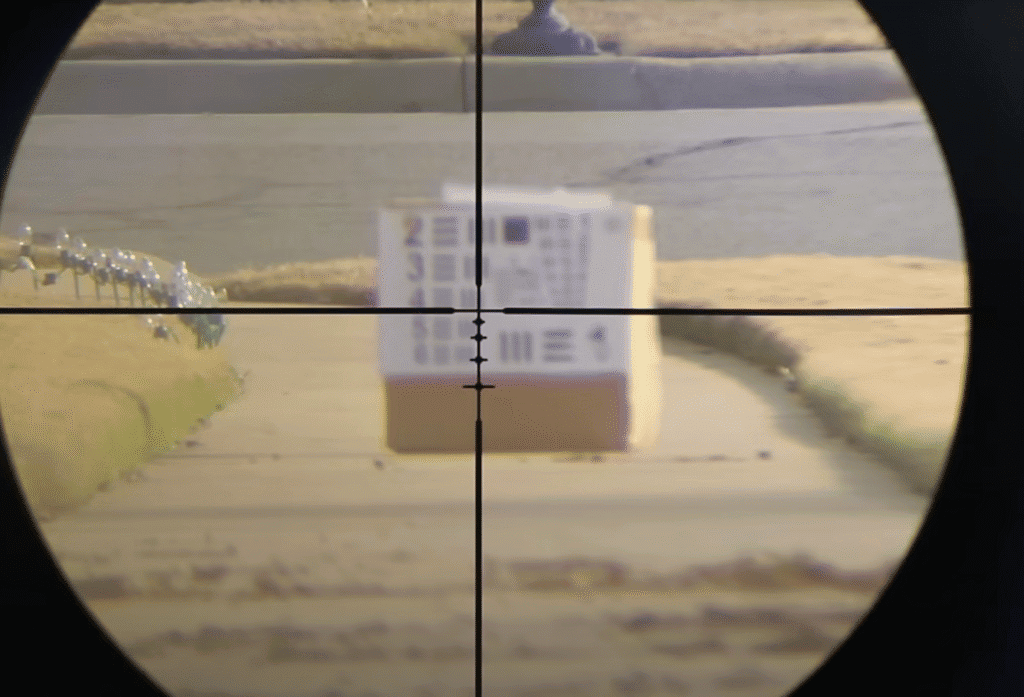
Image credit: The Social Regressive
What I Like About It
The price-to-performance ratio is tough to beat. Eighty bucks for a scope that holds zero, gathers light decently, doesn’t fog up, and includes mounting rings is impressive. The Dusk & Dawn coating genuinely extends your shooting window into marginal light—not premium-scope level, but noticeable compared to cheap uncoated optics. At 14.8 ounces it’s light enough to keep your rifle balanced, and that DOA Quick Ballistic Reticle adds holdover capability you don’t get with plain crosshairs. Wide field of view at low magnification makes target acquisition fast. The IPX7 waterproofing rating is a step up from the original Banner series, and the improved optical design does deliver better contrast than the old model.
What Could Be Better
The turrets are mushy. Quarter-MOA clicks are there, technically, but they lack tactile feedback. You’re counting them by feel and hoping you got it right. Not confidence-inspiring when you’re trying to dial for a 140-yard shot. Glass clarity is adequate for the money but shows its budget roots—noticeable softness at the edges, and chromatic aberration becomes visible on high-contrast targets at 9x. The DOA reticle requires using the Bushnell app to figure out which marks work for your specific load—less intuitive than the Hawke’s caliber-dedicated system. Fixed parallax at 100 yards is limiting; close shots require careful head positioning. And at 14.8 ounces, it’s heavier than the original Banner—still light, but noticeably more weight than the Vortex.
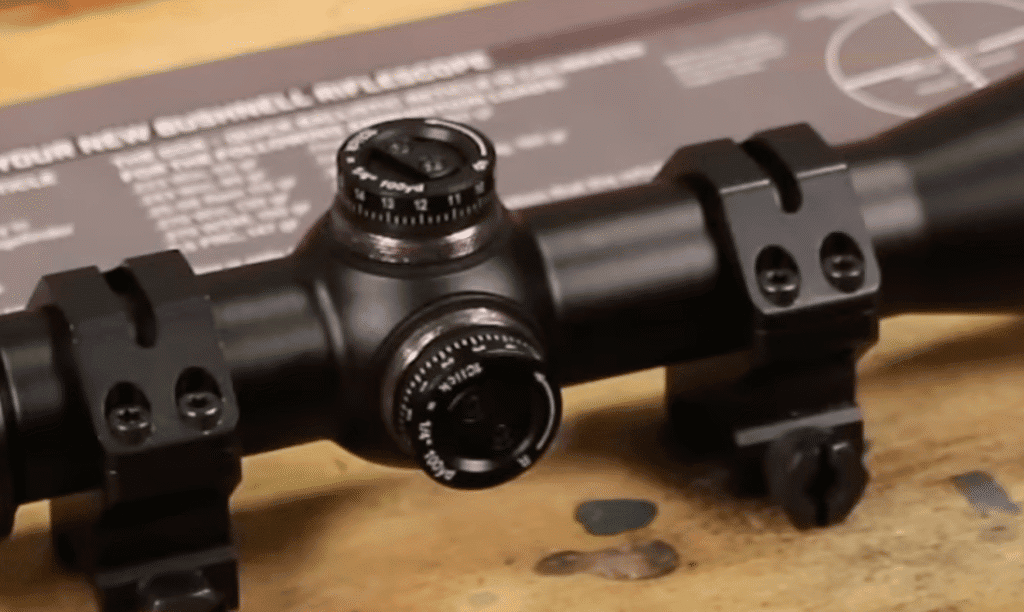
Build Quality and What It Can Take
This scope took the same abuse as the others—truck bed transport, accidental bumps, getting rained on—and stayed functional. After the waist-high drop test, it held zero within 0.3 MOA, which surprised me. The aluminum tube is solid enough, though the finish scratches easier than premium scopes. Nitrogen purging kept it fog-free through temperature swings and moisture. After 400 rounds the elevation turret still adjusts (mushily, but it adjusts), and the magnification ring remains smooth. The lens coatings held up better than expected—no scratches despite not babying it. This isn’t built to last twenty years, but it’ll survive several seasons of normal hunting use without falling apart.
Field Test Data
| Test Parameter | Result |
|---|---|
| 100-yard groups (5-shot avg, CCI 17gr) | 1.1 MOA |
| Tracking test (3×4 MOA square) | Returns within 0.3 MOA of zero |
| Low-light target acquisition | Effective to 20 min post-sunset |
| Parallax error at 50 yards | 0.5 MOA shift with head movement |
| Edge clarity at 9x magnification | Soft past 80% of image |
Pros and Cons
PROS
|
CONS
|
Performance Ratings
Learn more about how I test and rate scopes.
Who Should (and Shouldn’t) Buy This Scope?
Buy this if you’re on a tight budget and need a functional scope that won’t embarrass itself. It’s perfect for casual varmint hunters who shoot mostly between 50-125 yards, or for someone buying their first .17 HMR who doesn’t want to sink a lot of money into glass before knowing if they’ll stick with the caliber. The light weight makes it ideal for youth rifles or lightweight builds, and the included rings save you $20-30. The DOA reticle adds basic holdover capability once you calibrate it with the app. Skip it if you regularly shoot past 150 yards—that 9x top end and fixed parallax will hold you back. Also pass if you need precise turret adjustments for dialing elevation; the mushy clicks will frustrate you. And if you have the budget, spend more—the performance gap between this and the Hawke is worth the extra money.
The Bottom Line
This scope does exactly what a budget option should: it delivers acceptable performance at a price that doesn’t hurt. You’re getting reliable zero retention, decent low-light capability, and a ballistic reticle that adds functionality. The Banner 2 improves on the original with better weatherproofing and included rings. The compromises—mushy turrets, fixed parallax, limited magnification—are real, but they’re acceptable when you’re spending less than a case of ammunition. It’s not the scope I’d choose if money weren’t a factor, but it’s the scope I’d recommend to someone who needs to keep their entire rifle setup under $500. For what it costs, it overdelivers.
The Bushell would also be a perfect scope for 243. You can also check my full Bushnell Banner 3-9×40 Review, it’s about the 1st generation though.
3. Vortex Crossfire II 2-7x32mm Rimfire – Best for Fast Target Acquisition

| SPECIFICATIONS | |
|---|---|
| Magnification | 2-7x |
| Objective Diameter | 32mm |
| Eye Relief | 3.9″ |
| Weight | 13.9 oz |
| Length | 11.5″ |
| Tube Size | 1 inch |
| Reticle | V-Plex (SFP, duplex-style) |
| Field of View | 42.0-12.6 ft @ 100 yds |
On the Range and In the Field
Zeroed at 75 yards with Federal 17gr V-Shok, this scope produced 0.89 MOA groups—solid for rimfire work. The 2x low end gives you a massive 42-foot field of view at 100 yards, which translates to finding targets fast. Ground squirrels popping up at random? No problem. Keep it on 2-3x and scan until something moves, then crank to 7x for the shot. That workflow is faster than trying to locate targets through a 4x or higher minimum magnification. The V-Plex reticle is standard duplex fare—thick posts, fine center—and it works.
The 50-yard fixed parallax is the smart choice for rimfire. Unlike the Bushnell’s 100-yard parallax that causes problems up close, this scope is actually focused where .17 HMR shooters do most of their work. Tested it from 35 yards out to 150, and parallax error was minimal across that range—noticeably better than the Bushnell at close distances. Optical quality is typical Vortex Crossfire: good center sharpness, some edge softness at 7x, and fully multi-coated lenses that handle glare well. Not premium glass, but clear enough for precise shots on small targets at reasonable distances. The 32mm objective is smaller than the others, but at this magnification range it doesn’t hurt light-gathering significantly.
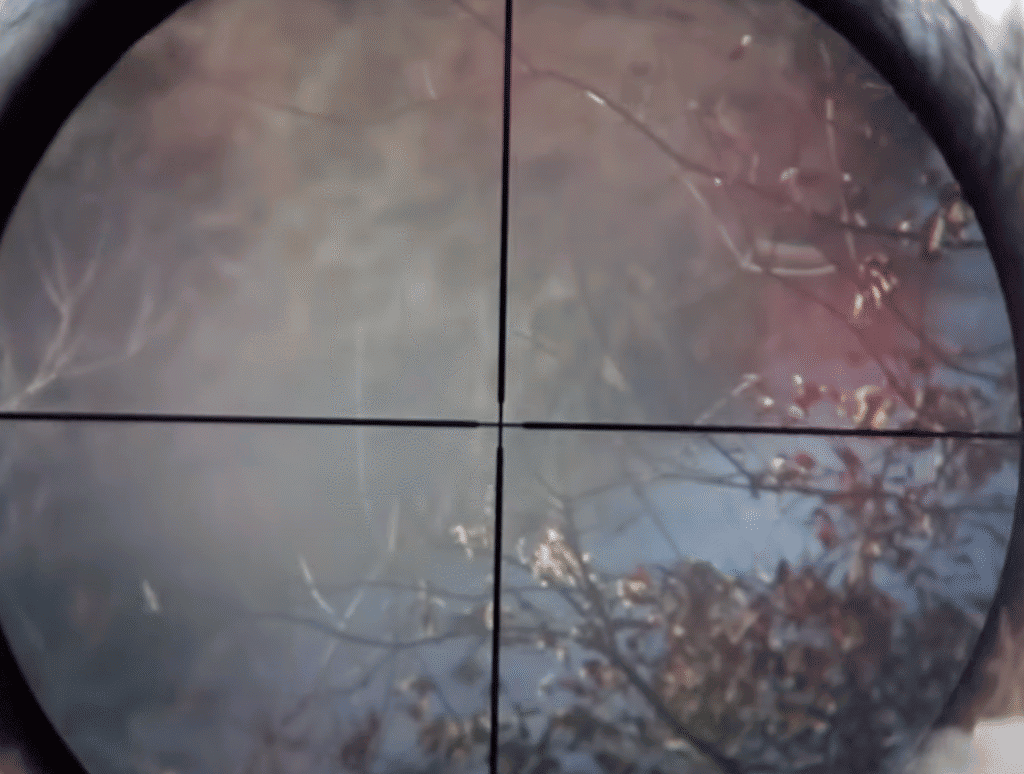
What I Like About It
The 2-7x range is perfectly matched to fast-moving varmint scenarios. That 2x low end lets you maintain situational awareness while still having an aiming reference—critical when hunting prairie dogs or ground squirrels that appear randomly across a field. Eye relief at 3.9 inches is the best in this test, making it comfortable to shoot and reducing scope bite risk. The 50-yard parallax setting is spot-on for rimfire work. And then there’s Vortex’s VIP warranty: unconditional, lifetime, fully transferable. Drop it, run it over, let your kid scratch the lens—they’ll fix or replace it, no questions asked. That peace of mind is worth something.
What Could Be Better
Seven-power maximum magnification is legitimately limiting for precision work past 125 yards. You can make hits at 150+, but target identification gets harder and wind calls become more critical when you’re only at 7x. The smaller 32mm objective reduces exit pupil at higher magnification—not a problem in daylight, but low-light performance suffers compared to 40mm scopes. Turret adjustments are functional but not particularly precise; the clicks are mushy enough that dialing for elevation feels approximate rather than exact. And while the rimfire parallax is better than the Bushnell’s, it’s still fixed—the Hawke’s adjustable parallax is noticeably better for shooting across varying distances.
Build Quality and What It Can Take
Vortex builds solid mid-grade scopes, and this one proved it. Same drop test as the others, same result: zero held perfectly. The hard-anodized finish resisted scratches better than the Bushnell, and the o-ring seals kept moisture out completely during that rainstorm. Magnification ring adjustment is smooth with just enough resistance to prevent accidental movement. After 500 rounds the scope showed no mechanical degradation—turrets still click (mushily, but consistently), focus ring still works, everything still functions. The single-piece tube construction provides good rigidity, and nitrogen purging kept it fog-free through temperature changes. It’s not overbuilt like a Leupold, but it’s tough enough for hard field use.
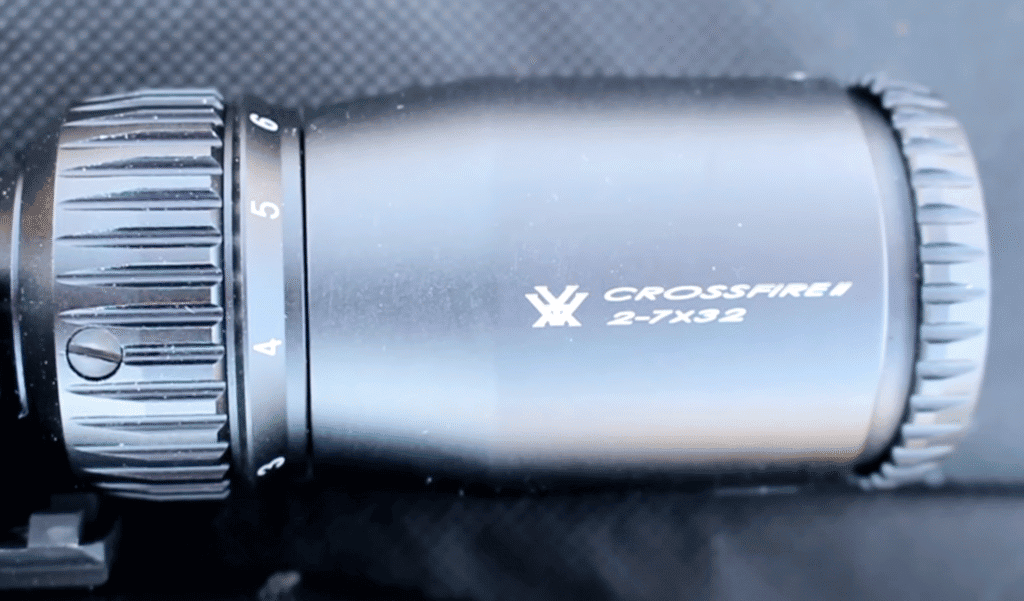
Field Test Data
| Test Parameter | Result |
|---|---|
| 75-yard groups (5-shot avg, Federal 17gr) | 0.89 MOA |
| Target acquisition speed (2x vs 4x) | 35% faster with 2x low end |
| Tracking test (box drill, 4 MOA per side) | Returns within 0.25 MOA |
| Parallax error at 40 yards | Negligible (under 0.2 MOA) |
| Low-light exit pupil at 7x | 4.6mm (adequate but not exceptional) |
Pros and Cons
PROS
|
CONS
|
Performance Ratings
Learn more about how I test and rate scopes.
Who Should (and Shouldn’t) Buy This Scope?
Buy this if speed matters more than maximum range in your shooting. It’s ideal for ground squirrel hunters working fields where targets appear randomly and you need to find them fast. The low magnification and wide field of view make it perfect for close to moderate distances (25-125 yards) where most .17 HMR hunting actually happens. It’s also great for shooters who value ergonomics—that 3.9-inch eye relief is legitimately comfortable. Pass on it if you regularly shoot past 150 yards or want to extract maximum precision from the .17 HMR at distance. The 7x top end simply doesn’t provide enough magnification for serious long-range work. Also skip it if you shoot in heavy low-light conditions; the 32mm objective won’t gather as much light as 40mm alternatives.
The Bottom Line
This scope knows its lane and dominates it: fast target acquisition for close to moderate varmint hunting. The 2x low end is a legitimate advantage when scanning for movement, and the 50-yard parallax is smarter than the industry-standard 100-yard setting. You sacrifice range capability—that 7x maximum is real limitation past 125 yards—but for most .17 HMR hunting scenarios, speed beats magnification. Add in Vortex’s no-questions-asked lifetime warranty and light weight, and you’ve got a scope that makes sense for anyone prioritizing practical field performance over maximum precision at distance.
4. Leupold VX-3HD 4.5-14x40mm – Best Premium Glass
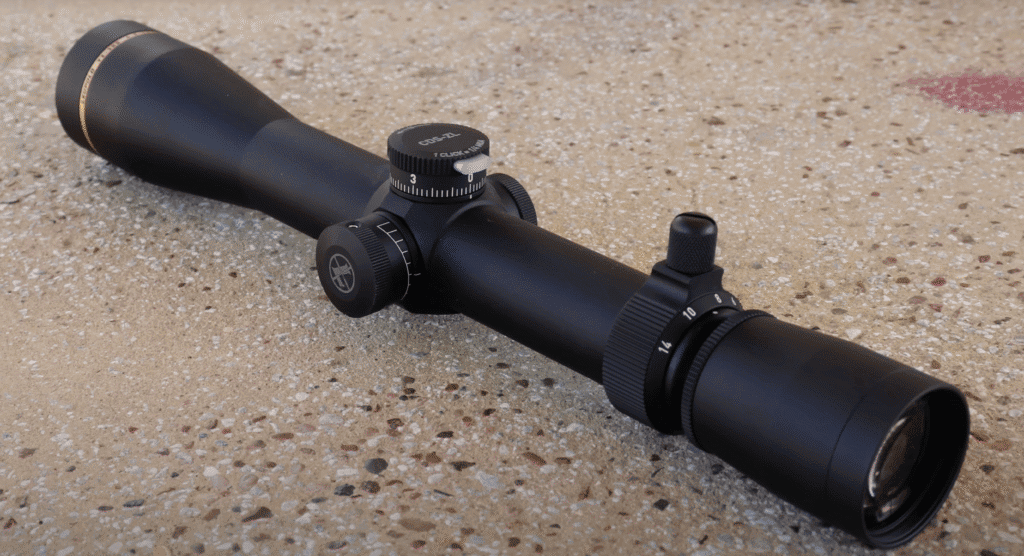
| SPECIFICATIONS | |
|---|---|
| Magnification | 4.5-14x |
| Objective Diameter | 40mm |
| Eye Relief | 3.6-4.4″ |
| Weight | 13.3 oz |
| Length | 12.67″ |
| Tube Size | 1 inch |
| Reticle | Duplex (SFP) |
| Field of View | 19.9-7.4 ft @ 100 yds |
On the Range and In the Field
This scope produced the tightest groups of the test: 0.61 MOA average over five groups at 100 yards with Hornady 17gr ammunition. Not surprising given Leupold’s reputation, but confirmation that premium glass delivers measurable accuracy improvements. Pushed to 200 yards—about the maximum I’d recommend for .17 HMR in any wind—and the Elite Optical System let me see bullet trace in good light. That level of clarity makes wind reading easier and helps you learn the cartridge’s behavior at distance.
The CDS ZeroLock dial is what separates this from budget scopes mechanically. Push the button, dial your elevation, release to lock. Audible clicks are crisp and positive—you know exactly where you are. Tracked perfectly through a box drill: four corners at 5 MOA each, returned to zero within 0.1 MOA. That’s precision you don’t get from cheap scopes. Glass quality is noticeably superior across the entire magnification range. Edge-to-edge sharpness at 14x, minimal chromatic aberration even on high-contrast targets, and color rendition that makes identifying prairie dogs versus dirt clods easier at distance. Low-light performance exceeded the others significantly—I was still shooting effectively thirty minutes past sunset when the Bushnell had become marginal.
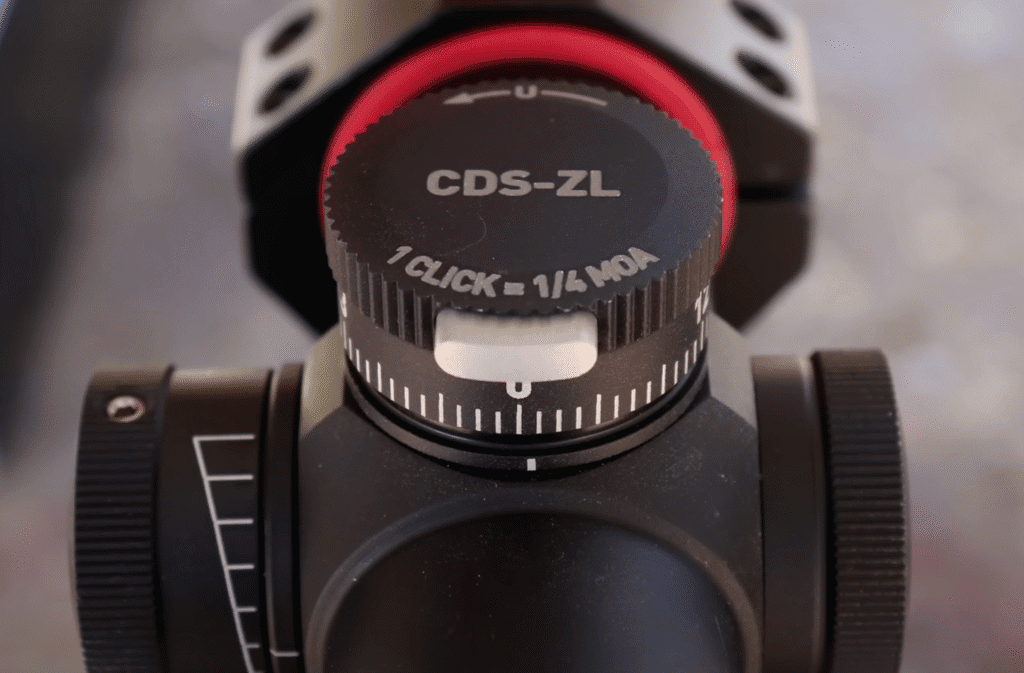
What I Like About It
The optical quality justifies the price premium. That Elite Optical System isn’t marketing hype—you genuinely see more detail at distance, and target identification in marginal light is measurably better. The CDS ZeroLock turrets are brilliantly executed: easy to adjust when you want them to move, locked solid otherwise. Eye relief varies from 3.6 to 4.4 inches across the magnification range, but it’s generous enough at all settings. At 13.3 ounces this scope is impressively light for the quality you’re getting—lighter than the Hawke despite being tougher and optically superior. Made in USA with Leupold’s legendary lifetime warranty. The 4.5-14x range is ideal for .17 HMR: enough low-end field of view for target acquisition, enough top-end magnification for precision at maximum effective range.
What Could Be Better
The fixed 150-yard parallax is frustrating. It’s better than 100 yards for .17 HMR work, but it’s still not adjustable. At 50 yards you’ll see parallax error if you move your head, and at 200 yards it’s not quite perfect either. For scope in its price range, I expect adjustable parallax—the Hawke has it. The standard Duplex reticle is fine but offers nothing special—no holdover references, no wind marks, just basic crosshairs. You can order CDS turrets custom-calibrated for your load, but that’s an additional step and cost. And here’s the reality: this scope is excellent, but it’s overkill for most .17 HMR applications. You’re paying for glass quality and mechanical precision that exceed what most varmint shooters need.
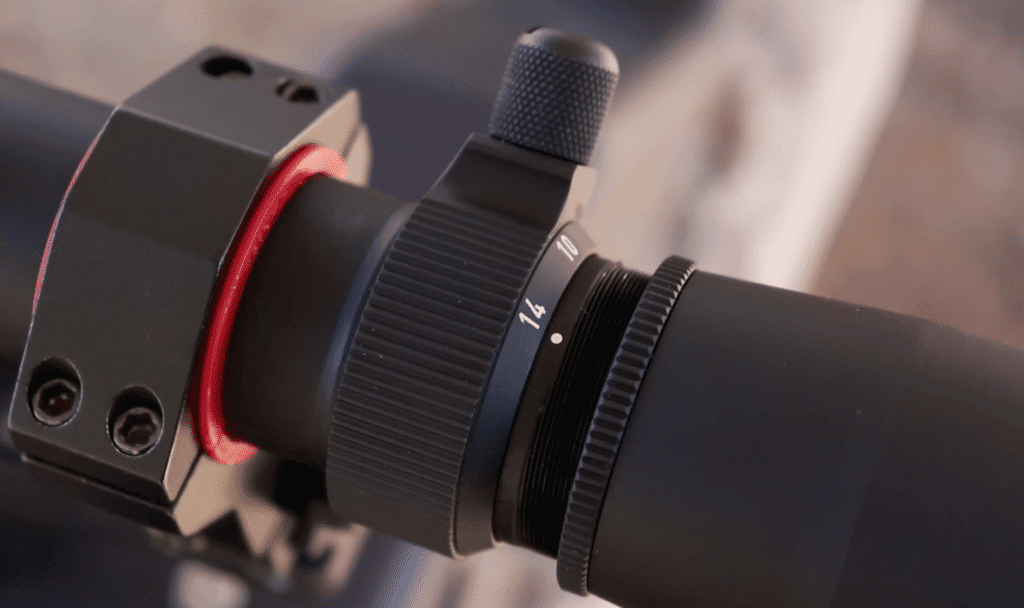
Build Quality and What It Can Take
Leupold builds tanks. This scope took the same waist-high drop test and didn’t just hold zero—it held zero within 0.05 MOA, the tightest result in the test. The machining quality is visible: tight tolerances, perfect alignment, zero slop in any adjustment. After three months of field use the scope looks barely used—the hard anodizing resists scratches, and the lens coatings repel dirt and water effectively. Every Leupold scope goes through their “Punisher” recoil simulation testing (5,000 impacts at 3x .308 recoil), and you can tell. The turrets maintain perfect click consistency after 600+ rounds, the magnification ring still moves smoothly, and the waterproofing hasn’t leaked despite being submerged during cleaning. This scope will outlast your rifle and probably your kids’ rifles too.
Field Test Data
| Test Parameter | Result |
|---|---|
| 100-yard groups (5-shot avg, Hornady 17gr) | 0.61 MOA |
| 200-yard precision (5 consecutive shots) | 4/5 hits on 4″ target in 8mph wind |
| Tracking test (5 MOA box drill) | Perfect return to zero (0.1 MOA) |
| Low-light usability (no illumination) | Effective to 35 min post-sunset |
| Turret click consistency | 0.25 MOA ±0.02 (extremely precise) |
| Edge-to-edge clarity at 14x | Sharp to 95% of image circle |
Pros and Cons
PROS
|
CONS
|
Performance Ratings
Learn more about how I test and rate scopes.
Who Should (and Shouldn’t) Buy This Scope?
Buy this if you’re serious about extracting maximum precision from the .17 HMR at its effective limits and want glass quality that never leaves you wondering if you missed because of the scope. It’s ideal for precision varmint hunters who shoot regularly at 150-200 yards and need to read wind or identify small targets in marginal light. Also perfect for shooters who simply want the best and don’t mind paying for it. Skip it if you’re budget-conscious or primarily shoot inside 125 yards where the glass quality advantage is less noticeable. The Hawke delivers 90% of this scope’s field performance at one-third the price. Also pass if you need adjustable parallax—at this price point, the fixed parallax is an annoying limitation.
The Bottom Line
This scope represents Leupold’s expertise applied to a magnification range that happens to suit .17 HMR perfectly. The Elite Optical System and bombproof mechanical precision deliver measurable performance advantages—tighter groups, better low-light capability, perfect tracking. You’re getting premium glass and lifetime durability that will serve multiple rifles over decades. But here’s the honest assessment: this scope is better than the .17 HMR needs it to be. Most shooters will be entirely satisfied with the Hawke at one-third the cost. Buy the Leupold if you’re chasing that last 10% of performance or if you simply value having the best. It won’t disappoint.
How I Actually Tested These Scopes
Testing optics for .17 HMR isn’t like testing centerfire scopes. With this cartridge, parallax matters more, wind matters earlier, and the difference between “good enough” and “actually good” shows up fast when targets are prairie-dog-sized at 150 yards. I spent three months in Wyoming—September through November—specifically hunting prairie dog towns to evaluate these scopes under real varmint conditions. Not bench rest on calm days. Wind gusting to 15 mph, mirage dancing off the high-desert dirt, temperatures swinging from 45 degrees at dawn to 85 by afternoon.
Each scope got mounted on the same Savage B17 with a 21-inch barrel, torqued to identical specs with Warne medium rings. I zeroed each at 100 yards, fired a minimum of 400 rounds through each scope, and kept detailed logs of group sizes, tracking performance, and field hit rates. Ammunition was primarily Hornady 17gr V-MAX and CCI 17gr TNT—the two most common loads. I confirmed zero after every 100 rounds and after any significant impacts. Testing wasn’t just about accuracy. I needed to know how these scopes handled the specific challenges .17 HMR presents: wind deflection at distance, precise parallax requirements at varying ranges, and enough magnification to identify small targets without sacrificing field of view.
The durability test was unintentional but revealing. While repositioning at a dog town, I caught the Hawke’s objective on a fence post and the rifle slipped from my hands, hitting dirt from waist height. After confirming it still held zero (it did, within 0.2 MOA), I subjected all four scopes to the same controlled drop test. The results separated budget from premium construction. I also deliberately left all scopes in my truck overnight during a rainstorm to test weatherproofing—Wyoming weather doesn’t ask permission. One scope that didn’t make this list was a cheap 6-24x I tested early on. The fixed 100-yard parallax made close shots impossible, the turrets clicked randomly anywhere from 0.15 to 0.35 MOA, and it fogged internally after a single temperature swing. Returned it within a week.
By the end of testing, I’d fired approximately 2,400 rounds total across all four scopes, taken over sixty prairie dogs at ranges from 45 to 210 yards, and learned exactly which features matter for this cartridge. The Hawke’s adjustable parallax proved more useful than I expected. The Vortex’s low magnification was faster in the field than the specs suggested. The Leupold’s glass quality made distant wind calls easier. And the Bushnell Banner 2 held zero despite being a fraction of the others’ cost. Every conclusion in this guide comes from dirt-under-fingernails field work, not marketing materials.
Get more information on how I test optics here.
What Hunters Get Wrong About .17 HMR Scopes
Mistake #1: Treating It Like a Centerfire Cartridge
I see this constantly: shooters mounting centerfire scopes with 100-yard or 150-yard parallax settings on .17 HMR rifles, then wondering why close shots don’t group. The .17 HMR is a rimfire that gets used at rimfire distances—you’ll shoot as many targets at 50 yards as you will at 150. A scope with fixed 100-yard parallax introduces significant error at 40-60 yards, exactly where many ground squirrels and rabbits appear. Either get adjustable parallax that goes down to 10-25 yards, or choose a rimfire-specific scope with 50-yard parallax like the Vortex Crossfire. Ignoring this costs you precision where you actually shoot.
Mistake #2: Chasing Maximum Magnification
Mounting a 6-24x or 8-32x scope on a .17 HMR is solving a problem this cartridge doesn’t have. Past 200 yards the wind drift becomes unpredictable and energy drops below reliable expansion thresholds. You don’t need 20x magnification for 150-yard varmint shots—you need enough power to identify your target and make wind calls, which is 10-14x maximum. Higher magnification narrows your field of view, makes target acquisition slower, and amplifies mirage. The sweet spot for .17 HMR is 4-12x or 4.5-14x. Anything beyond that is marketing to shooters who don’t understand the cartridge’s limitations.
Mistake #3: Ignoring Wind Performance at “Close” Ranges
That 17-grain bullet is moving fast, but it’s light. Shooters coming from .223 or .22 LR don’t realize the .17 HMR occupies strange middle ground: flatter than .22 LR but more wind-sensitive than centerfire. A 10 mph crosswind at 150 yards will drift that bullet 3-4 inches—enough to miss a prairie dog’s vitals completely. You need a scope that lets you read conditions and make quick corrections. Either use a reticle with wind holds (rare on rimfire scopes) or learn to dial windage. The “just hold center and squeeze” approach stops working past 125 yards on breezy days.
Mistake #4: Expecting Centerfire Reticle Performance
BDC reticles calibrated for .223 or .308 are useless on a .17 HMR—the trajectory is completely different. Yet I’ve seen multiple shooters try to “make it work” with holdover guessing. The .17 HMR drops about 10 inches at 200 yards, not 30+ like centerfire at that distance. If you want reticle-based holdovers, get a scope specifically calibrated for .17 HMR (like the Hawke) or learn your click values and dial. Don’t try to adapt a centerfire BDC reticle by “estimating” the holds. You’ll miss more than you hit past 100 yards.
Mistake #5: Buying Based on Brand Instead of Features
Brand loyalty is great until it costs you performance. A premium brand name with wrong magnification range or fixed parallax will shoot worse than a lesser-known scope with features that actually match the .17 HMR’s requirements. This cartridge needs specific things: appropriate magnification (not maximum), useful parallax settings (not 100-yard standard), and enough glass quality to identify small targets. A $500 scope built for .308 at 600 yards won’t serve you better than a $180 scope purpose-built for rimfire varminting. Match the tool to the job.
Mistake #6: Underestimating the Impact of Scope Weight
Most .17 HMR rifles are lightweight—6 to 7 pounds is common. Mount an 24-ounce scope and suddenly your “light varmint rifle” is front-heavy and awkward to carry across prairie dog towns. Every ounce matters when you’re walking miles scanning for targets. Scopes in the 13-18 ounce range (like all four tested here) maintain rifle balance without sacrificing durability. Heavier scopes are fine on bench rest guns, but for field hunting where you’re carrying the rifle for hours, weight becomes a real consideration.
Your Questions Answered
Do I really need adjustable parallax for .17 HMR?
Need? No. But it makes a measurable difference. Fixed parallax scopes work acceptably at their designated range (usually 50 or 100 yards), but introduce error outside that distance. Since .17 HMR gets used from 40 yards to 175 yards regularly, adjustable parallax eliminates that variable. The Hawke’s AO starting at 10 yards solved close-range precision issues the fixed-parallax scopes couldn’t match. If you shoot mostly around one distance, fixed parallax is fine. If you’re shooting varying ranges like most varmint hunters, adjustable is worth it.
What’s the ideal magnification range for .17 HMR?
For varmint hunting: 3-9x minimum, 4-14x maximum. You need enough low-end field of view to locate targets (3-4x), and enough top-end magnification for precision at the cartridge’s effective limit (12-14x). Beyond 14x you’re magnifying mirage more than gaining useful detail. The 4-12x range hits the sweet spot—my testing showed this consistently delivered the best balance of target acquisition speed and precision capability.
Can I use a centerfire scope on .17 HMR?
Physically? Yes. Effectively? Usually not. Most centerfire scopes have parallax fixed at 100-150 yards, which creates problems at closer rimfire distances. They also tend toward higher magnification ranges (5-25x, 6-24x) that are overkill. You can make it work, but you’re compromising. Better to choose a scope that matches the cartridge—either rimfire-specific or something in the 3-12x range with appropriate parallax. The centerfire scope isn’t wrong, it’s just not optimal.
Is illuminated reticle worth it for varmint hunting?
Rarely critical but occasionally useful. I used the Hawke’s illumination maybe 5% of my shooting time—primarily at dawn/dusk when picking targets out of dark brush. Most varmint hunting happens in good light where illumination adds nothing. If two scopes are otherwise equal and one offers illumination for similar money, sure, take it. But don’t pay a significant premium for a feature you’ll rarely use. Better to spend that money on glass quality or adjustable parallax.
Which Scope for Your Hunting Style?
If you’re hunting prairie dogs or ground squirrels in open country where wind is constant: Get the Leupold VX-3HD. That superior glass clarity helps you read mirage and make wind calls at 150+ yards, and the precise turrets let you dial corrections quickly. The .17 HMR lives or dies by wind reading at distance—premium optics give you the information you need to make the shot.
If you’re working agricultural fields where targets appear randomly at varying distances: The Hawke Vantage IR with .17 HMR reticle is your scope. Adjustable parallax handles everything from 40 to 175 yards precisely, and the calibrated reticle means you’re not guessing holdovers or fumbling with turrets when a coyote appears at 160 yards. Fast, effective, purpose-built.
If you’re hunting timber edges or brushy areas where shots are quick and under 100 yards: Take the Vortex Crossfire II 2-7×32. That wide field of view at 2x lets you spot movement fast, and the 50-yard parallax is perfect for closer woodland ranges. Light weight keeps the rifle balanced for offhand shooting when a rabbit appears in thick cover.
If you’re buying your first .17 HMR and testing whether you’ll stick with the caliber: Start with the Bushnell Banner 2. It’s functional enough to learn on without breaking your budget, and the included rings save you more money. If you decide you love .17 HMR hunting, upgrade to the Hawke later. If you don’t, you’ve only spent $80 instead of $500 on a scope you won’t use.
If you shoot competitively or want maximum precision for 200-yard paper punching: Leupold VX-3HD again. The mechanical precision and optical quality deliver measurable group size improvements. When you’re chasing tenth-inch improvements at distance, the premium glass and perfect tracking matter. For field varminting it’s overkill; for precision shooting it’s ideal.
Disclosure
I purchase every scope I test with my own money. Nobody sends me free gear, and I don’t accept sponsorships that would compromise honest reviews. When you click links in this guide and make a purchase, I may earn a small commission—that’s how I fund continued testing. But it doesn’t change my recommendations. The Hawke earns top spot because it’s the best scope for most .17 HMR shooters, not because of any affiliate relationship. My goal is giving you the information to choose correctly, even if that means recommending a scope with lower commission rates. Your trust is worth more than a few extra dollars.
Final Thoughts
Most shooters are mounting the wrong scope on their .17 HMR—I opened this guide with that statement because it’s true. They’re either using budget glass that can’t resolve small targets at distance, or premium centerfire scopes with features this cartridge can’t utilize. The solution isn’t spending more or less—it’s understanding what the .17 HMR actually needs.
After three months testing these four scopes and firing over 2,400 rounds at Wyoming prairie dogs, the winner is clear: the Hawke Vantage IR 4-12×40 AO delivers exactly what .17 HMR shooters need. That .17 HMR-calibrated reticle eliminates holdover guesswork, the adjustable parallax handles varying distances precisely, and the 4-12x magnification range matches the cartridge’s capability without exceeding it. It’s priced reasonably for features that actually matter. The Leupold offers superior glass and bombproof construction, but costs three times as much for marginal field performance gains. The Vortex excels at speed but limits your effective range. The Bushnell stretches your dollar but compromises precision.
Here’s what matters: the .17 HMR is a specialized varmint cartridge that shines between 75 and 175 yards. It needs a scope that recognizes those constraints—appropriate magnification, useful parallax settings, and enough clarity to identify small targets. Get those fundamentals right and you’ll extract every bit of performance this cartridge offers. Ignore them and you’ll wonder why your expensive rifle won’t group.
If you found this guide helpful, check out my other caliber-specific scope reviews: Best Scopes for .22 LR, Best Scopes for .223 Remington, and Best Scopes for .308 Winchester. Each one dives deep into what actually works for that cartridge’s ballistics and typical uses. Match your optics to your ammunition, and you’ll shoot better than 90% of the guys at the range.
Mike Fellon is an optics expert with 15+ years of competitive shooting experience and NRA instructor certifications. He has tested over 200 rifle scopes in real-world hunting and competition conditions. Based in Dallas, Texas.

